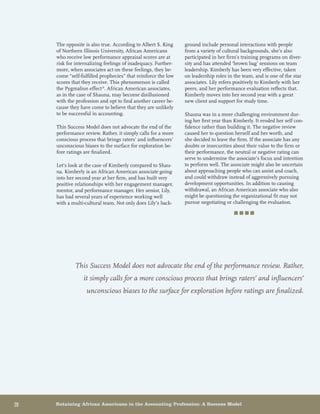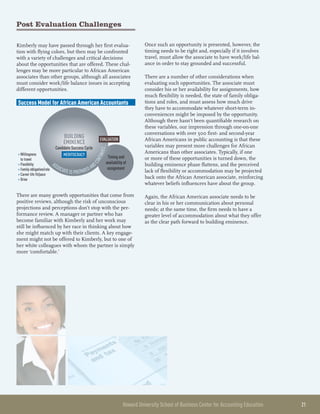The document presents a success model for retaining African Americans in the accounting profession. It identifies three key components: 1) all stakeholders must examine their own biases and expectations to create an inclusive environment, 2) organizations must establish inclusive structures, systems and culture, such as comprehensive onboarding programs, and 3) African American associates must build their professional reputation and relationships in their first two years. The model aims to address retention by focusing on both individual associates and making changes within accounting organizations and among those who make critical career decisions, like supervisors.
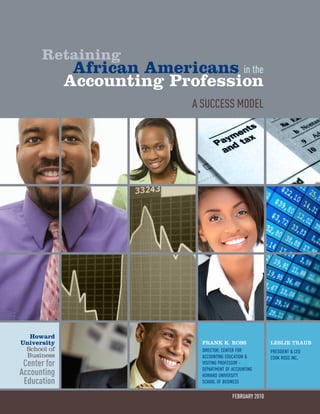
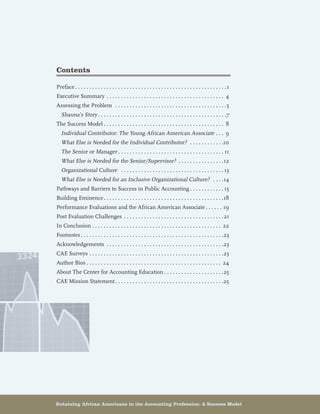
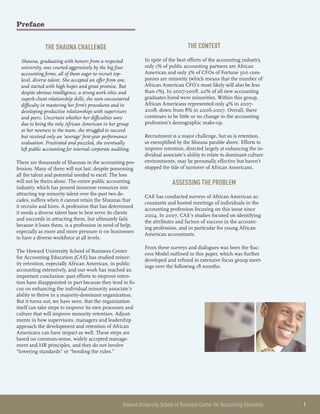
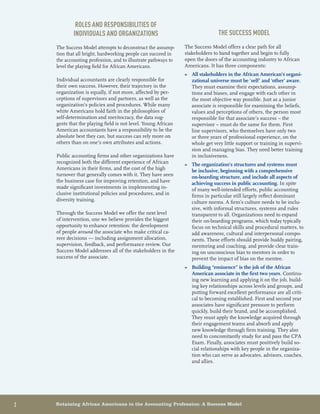
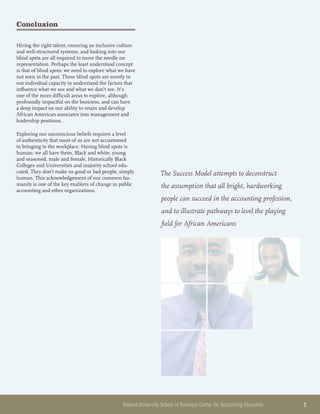

![Howard University School of Business Center for Accounting Education 5
Assessing the Problem
The Howard University School of Business Center
for Accounting Education(CAE) has conducted vari-
ous surveys of African American accountants and
hosted meetings of individuals in the accounting
profession focusing on this issue since 2004. These
individuals include partners in the Global 7 account-
ing firms, other national, local and regional firms,
minority-owned firms from around the country, rep-
resentatives from the National Association of Black
Accountants (NABA), the American Institute of Certi-
fied Public Accountants (AICPA), various state CPA
Societies, educators, and CFOs of corporations. As
a collective body, this group has addressed concerns
pertaining to recruitment, retention, promotion, and
development of African American accountants in the
United States.
As evidenced by the following statistics, very little
progress, if any, has been achieved in the area of hir-
ing and retaining African Americans in the account-
ing profession.
In 2007-2008, 22% of all new accounting gradu-
ates hired were minorities. This figure is down from
26% in the previous year. Within this group, African
Americans represented only 4% in 2007-2008, down
from 8% in 2006-2007.2
Overall, there continues to be little or no change in
the accounting profession’s professional demographic
make-up. According to data from AICPA:
Professional staff make-up – 17% are minorities, but»»
of those, only 3% are African American.
Partner make-up – 11% are minorities, but only 1%»»
are African American. This figure is also unchanged
since 2002.[3]
In 2007, CAE’s studies focused on identifying the at-
tributes and factors of success in the accounting pro-
fession, and in particular for young African American
accountants. The Success Model was born in these
dialogues, and CAE’s stakeholders contributed to its
development over the following 18 months. The Suc-
cess Model attempts to deconstruct the assumption
that all bright, hardworking people with business
savvy can be successful in the accounting profession,
and to illustrate pathways to level the playing field for
African Americans in this profession.
Individual accountants are clearly responsible for
their own success. However, we also know that their
trajectory in the organization is equally, if not more,
affected by perceptions of their seniors, managers,
performance managers, and partners in addition to
institutional policies and procedures. While many
white Americans may hold faith in the philosophies
of self-determination and meritocracy — that an indi-
vidual determines his or her success through study-
ing and working hard, applying oneself, building the
right relationships, and expecting to advance in their
careers — African Americans traditionally have a
different experience with paths to promotion and de-
velopment. They must also work as hard and smart as
whites — in fact, more so — but they also have to live
daily with stereotypes, stereotype threat, constant neg-
ative imaging in the media, and unconscious bias in
the organizations in which they work. Although some
may challenge this statement, the data suggests that
there isn’t a level playing field for all. Nonetheless, to
be successful in the accounting world as an African
American, there is a responsibility to be the absolute
best you can be as an individual, while recognizing
that real success relies more on others than on one’s
own attributes and actions.
The Success Model attempts to deconstruct the
assumption that all bright, hardworking people
with business savvy can be successful in the accounting
profession, and to illustrate pathways to level the
playing field for African Americans in this profession.](https://image.slidesharecdn.com/332daf70-b553-485e-82fb-96efe77c0300-150208120532-conversion-gate01/85/SUCCESSMODELFINALFEB2010-7-320.jpg)
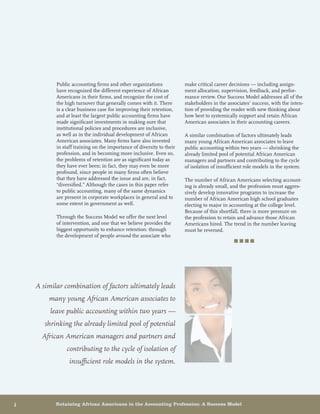
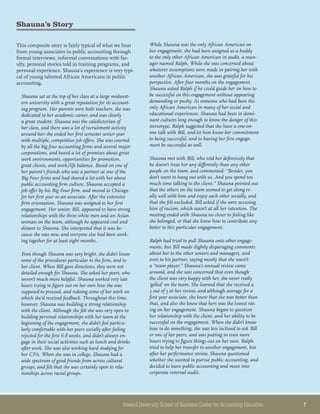
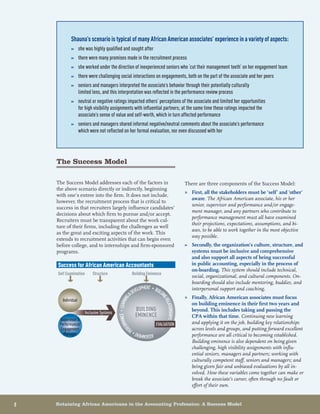

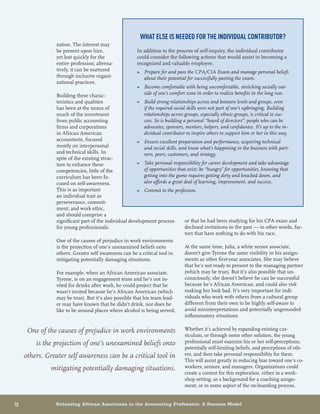


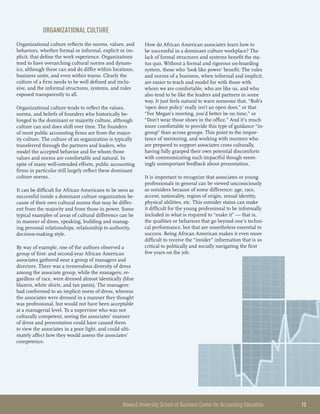
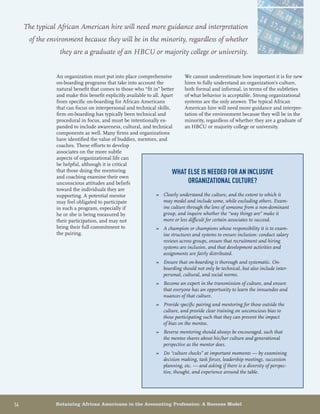
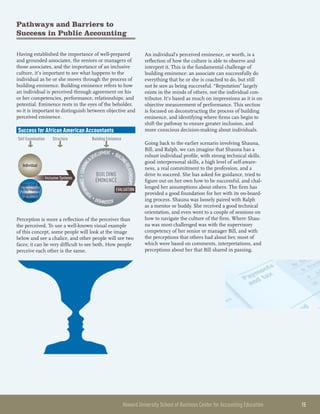
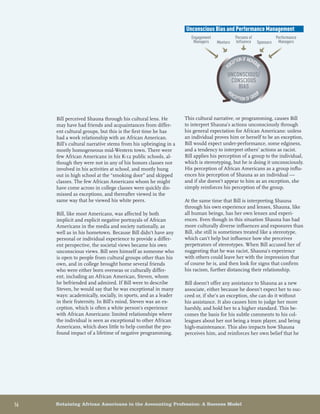
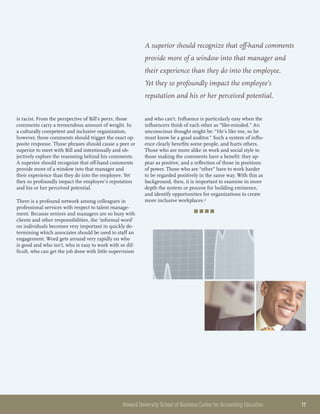
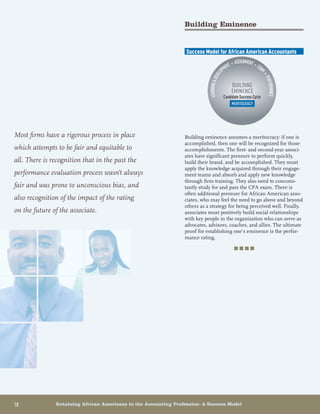
![Howard University School of Business Center for Accounting Education 19
Performance Evaluations and
the African American Associate
EVALUATION
Success Model for African American Accountants
Candidate Success Cycle
MERITOCRACY
BUILDING
EMINENCE
In a profession that generally presents itself as a meri-
tocracy, performance evaluations are the primary tools
to promote those who perform well, and to help those
who don’t to focus on the objective steps they need to
take to perform better. Most firms have a rigorous pro-
cess in place which attempts to be fair and equitable
to all. There is recognition that in the past the perfor-
mance evaluation process wasn’t always fair and was
prone to unconscious bias, and also recognition of the
impact of the rating on the future of the associate.
One of the significant aspects of the performance
evaluation process is the ultimate categorization of all
evaluatees into such groups as “top’, “middle” or “bot-
tom”. The intent is that the majority of the evaluatees
will be in the “middle” group. This middle group,
in many instances, is further categorized into “top
middle” and “lower middle”. Those in the “top” and
“top middle” will receive the highest raises, better as-
signments, etc. Again, most African Americans end
up in the “lower middle” and “bottom” groups pri-
marily because they do not have an advocate among
the evaluators.]
Lauren Stiller Rikleen, an attorney and advocate for
gender equity in the legal profession, wrote in Octo-
ber 2009 about the slow pace of women’s advance-
ment in the legal profession, including the relatively
small number of women as partners and members of
managing committees. Rikleen states that, not unlike
the accounting profession, the slow rise of women to
partner can be traced to “the unexamined biases that
influence decisions about assignments, compensation
and how people are evaluated and promoted. These
are not, to be clear, purposeful efforts to sabotage
careers…In the legal profession, ground zero for the
impacts of unexamined bias is the evaluation process.
This is where subjective decision-making and a lack
of clear policies and objective standards lead to mixed
messages and disparate treatment. Expert analysis
of these evaluations reveals the unintended conse-
quences that may arise from the implicit beliefs of the
evaluators.”5
The very same dynamic exists for African Americans
in the accounting profession. In addition to the actual
rating, there is often subtle wording in a review that
impacts how an associate is viewed. A positive rating
is shared among managers and seniors, and is a con-
sideration when making assignments to engagements.
This positive rating can have a halo effect on the asso-
ciate. The associate receives external validation of their
success and new opportunities that tell the associate
that he or she is valued. This clearly has a positive ef-
fect on both their performance moving forward, as
well as the perception of their performance.](https://image.slidesharecdn.com/332daf70-b553-485e-82fb-96efe77c0300-150208120532-conversion-gate01/85/SUCCESSMODELFINALFEB2010-21-320.jpg)
